![]()
Vintage American Paperweights for Sale
![]()
Vintage American Paperweights for Sale
The paperweights on this page are mostly from unidentified American glass companies. I usually refer to them as Midwest US or Vintage American. They may have been made in Indiana, Ohio, Pennsylvania, West Virginia, New Jersey, or even somewhere in Canada.
For more information about American paperweights from this period take a look at the book American Glass Paperweights and Their Makers by Jean Melvin (1967 and 1970). For some great references on paperweights, check out my list of paperweight books for sale.
If you would like to purchase
any of these paperweights, e-mail me at: aport@paperweights.com
| 5151 | Vintage Pairpoint Scrambled Millefiori
Paperweight. circa 1970s. This is a wonderful
millefiori paperweight with many interesting millefiori canes
placed on a clear ground. The canes are especially
nice. I believe this paperweight dates from the early 1970s
when William Burchfield was still at Pairpoint. The
paperweight is unsigned, but I guarantee the attribution.
This is the nicest Pairpoint scrambled millefiori paperweight I
have seen. A well balanced deign. Although many people collect scramble paperweights for their own merit, scrambles are also valuable tools for learning to identify the different colors and canes used by each factory. Pairpoint Glass has a long history extending back to its earliest origins with Mount Washington Glass in 1837. Owners and locations changed a number of times and the name Pairpoint was first used in the 1890s. The original Pairpoint companies were located in New Bedford, Massachusetts. In 1938, it was reorganized as Gunderson Glass Works by owner Robert Gunderson and later renamed the Gunderson - Pairpoint Glass Works in 1952. The name was acquired by Robert Bryden and the company moved briefly to East Wareham, MA in 1957 where it operated as the Pairpoint Glass Company. They leased production facilities in Spain. The last New Bedford factory burned down in 1965. In its latest iteration, Robert Bryden moved Pairpoint to Sagamore, Massachusetts in 1970. It continues to operate at that location today, with new owners in 2015. William Clark Burchfield started making paperweights at Pairpoint Glass in Sagamore, Massachusetts in 1970. He left in 1976 to form the Cape Cod Glass Works (also in Sagamore) which continued in operation until 2000. It then continued briefly in Crossville, Tennessee until 2001. Bill Burchfield died in 2012. Bill's son Mark was also at the Cape Cod Glass Works until 1998. Size: 2 3/8" diameter by 1 1/2" high. The
base is fire polished with a remnant of the pontil scar. For extra pictures, click on the picture at the right and the following links: Large pictureSOLD. Click on the picture to see a larger image. |
Click
on the picture to see a larger image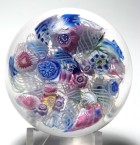 |
| 5887 | Vintage Pairpoint Concentric Millefiori
Paperweight. circa 1970s. This is a wonderful
spaced millefiori paperweight with thirteen fantastic millefiori
canes placed on a two layer turquoise ground. The canes are
especially nice. The ground has a translucent layer above an
opaque layer, which makes the canes look like they stand proud
above the ground but when viewed from the side it is clear that
the top of the canes are actually level with the top of the
translucent layer. It is faceted with a large top facet and five
side facets. The facets are concave. I believe this
paperweight dates from the early 1970s when William Burchfield was
still at Pairpoint. The paperweight is unsigned, but I
guarantee the attribution. This is the nicest Pairpoint
millefiori paperweight I have seen. A well balanced
deign.
Pairpoint Glass has a long history extending back to its earliest origins with Mount Washington Glass in 1837. Owners and locations changed a number of times and the name Pairpoint was first used in the 1890s. The original Pairpoint companies were located in New Bedford, Massachusetts. In 1938, it was reorganized as Gunderson Glass Works by owner Robert Gunderson and later renamed the Gunderson - Pairpoint Glass Works in 1952. The name was acquired by Robert Bryden and the company moved briefly to East Wareham, MA in 1957 where it operated as the Pairpoint Glass Company. They leased production facilities in Spain. The last New Bedford factory burned down in 1965. In its latest iteration, Robert Bryden moved Pairpoint to Sagamore, Massachusetts in 1970. It continues to operate at that location today, with new owners in 2015. William Clark Burchfield started making paperweights at Pairpoint Glass in Sagamore, Massachusetts in 1970. He left in 1976 to form the Cape Cod Glass Works (also in Sagamore) which continued in operation until 2000. It then continued briefly in Crossville, Tennessee until 2001. Bill Burchfield died in 2012. Bill's son Mark was also at the Cape Cod Glass Works until 1998. Size: Just over 2 5/8" diameter by 1 9/16"
high. The base is polished flat. For extra pictures, click on the picture at the right and the following links: Large picture$195 postage paid in the US. Click on the picture to see a larger image. |
Click
on the picture to see a larger image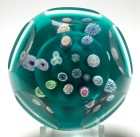 |
| 4435 | Large Tom Mosser Old Ironsides USS
Constitution Paperweight. circa 1970. This
classic decorative plaque paperweight was made by Thomas Mosser at
his Variety Glass Company in Cambridge Ohio. The white
enamel plaque is decorated with a printed decal image (ceramic
transfer) of an the Old Ironsides USS Constitution alongside a
dock. The rigging is present, but the sails have been stored
away. It is signed with an "M" in the lower edge of the
scene. The plaque rests on a multi-colored frit ground with
a second frit ground below. A great example from this
Cambridge Ohio maker. Note: This paperweight has a chip or imperfection which has been polished on the edge of the base. Please review the pictures. Thomas Mosser (born 1927) learned to work with glass at the Cambridge Glass Company where his father Orie Mosser was the plant manager. When Cambridge Glass closed in 1954, Tom decided to continue in the glass business and formed Variety Glass with the support of several experienced glass workers from Cambridge. The first couple of locations failed due to fires, but eventually a stable operation emerged and produced a variety of products, including glassware for the pharmaceutical industry, medical supplies, and also collectible molded items such as novelty salts, jam dishes, toothpick holders, ashtrays, and miniature boot and shoes. Tom also made paperweights to order as well as fixed designs for Shrine and Masonic lodges. Many of his paperweights used ceramic transfers of well known paintings by other artists. For more information, you can read about the Tom Mosser in the book American Glass Paperweights and Their Makers by Jean Melvin (revised 1970). The Mosser family continues to operate a glass business in Cambridge Ohio. Large size: 3 1/8" diameter by 2 1/2" high.
The base is polished flat. It weighs just over 21 ounces
and will be two pounds when packaged for mailing. For extra pictures, click on the picture at the right and the following links: Large pictureSOLD. Click on the picture to see a larger image. |
Click
on the picture to see a larger image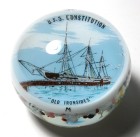 |
| 5699 | Large Antique Millville Umbrella
Paperweight. circa 1860-1912. This
style of old paperweight is associated with Millville, New
Jersey. Examples date from as early as 1860 and continued to
be made until about 1912. Many, if not all, were made at the
Whitall Tatum factory in Millville. The design consists of a
white mushroom shape with a center bubble. Additional
colored bits of glass are added and melted into the top. The
top is of the mushroom is pushed down with a crimp to form an
umbrella shape with ribs or pleats. The design is placed
over a white frit ground. This paperweight has minor flaws
including surface scratches and an abraded area on the side, but
displays beautifully. The design is well executed and
displays many of the typical Millville umbrella characteristics.
The umbrella shaped weights were originally modeled to resemble the wild tiger lily of Southern New Jersey. You can read about umbrella weights from Millville in the book Old Glass Paperweights of Southern New Jersey: An American Folk Art by Clarence A. Newell . It is not possible to identify the exact maker, but John Ruhlander, Emil Stanger, Marcus Kuntz, and Horace Rhubarth, and Ralph Barber are all known to have made weights of this style. Sometimes the style is also used as part of an inkwell or other object. Large Size : Just over 3" diameter by just under 2
3/4" high. The base is ground flat. For extra pictures, click on the picture at the right and the following links: Large picture$95 postage paid in the US. Click on the picture to see a larger image. |
Click on the picture
to see a larger image  |
| 5530 | Ed Rithner Eight Petal Teal Flower
Paperweight. circa 1940-1970. An upright flower
with eight teal green petals over a speckled green cushion
ground. Each petal has a white outline. The cushion
ground has four pleats with a carefully placed bubble between each
pleat. There is also a planned bubble in the center of the
larger flower at the top. A classic Rithner design.
Ed Rithner worked in Wellsburg, West Virginia from 1908 to the 1970s or later. You can read about Ed Rithner in Jean Melvin's book on American Glass Paperweights and their Makers . All of Rithner's weights are unsigned. Large size: 3" diameter by 2 3/8" high. The
base is fire finished and then ground to a matte finish in the
center to remove the pontil mark. For extra pictures, click on the picture at the right and the following links: Large pictureSOLD. Click on the picture to see a larger image. |
Click on the picture
to see a larger image 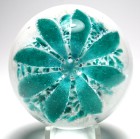 |
| 1579 | Vintage Vintage Midwest US Floral Design
Dump Paperweight with a Double Cross Pattern. circa
1900-1940. This is a very large paperweight with a
double cross pattern made up of colored glass rods (stringers)
with white frit between the rods. The rods extend down to
the base. There is a colorful trumpet shaped frit layer
below the cross pattern. And a large bubble in the center of
the cross. The paperweight or dump was made by an unknown
maker, probably in the Midwest US. The base is fire finished
with a pronounced pontil scar. This has all the characteristics of a true whimsy, made in spare time by a glass worker. I believe this was made in the midwest US in the first half of the 20th century. Very large size: 3 3/4” diameter by 3 3/16”
high. The base is fire finished with a pronounced pontil
scar. It weighs just under 2 pounds 15 ounces and will be
four pounds when packaged for shipping. For extra pictures, click on the picture at the right and the
following links: Large
picture $95 postage paid in the US. Click on the picture to see a larger image. |
Click
on the picture to see a larger image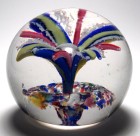 |
| 2048 | Magnum Antique Graeser Order of Elks
Paperweight. circa 1890. This uniquely American
style paperweight features a detailed image of an elk with very
large antlers above the logo "B.P.O.E." logo for the "Benevolent
and Protective Order of Elks". On each side of the elk are
two colorful hand painted floral sprays, each with a large light
pink or amber rose. There is a clock pointing to the 11
o'clock hour in the center below the elk. The elk and hand
painted spray are placed on a white enamel disk. The image
at the center was printed onto the white disk using a photographic
process developed by William Maxwell and commercialized by Albert
Graeser. After the decorations were complete the disk was
encased in glass. The hand painted floral sprays and large
roses are outstanding. A wonderful paperweight. Note on colors: The pictures don't capture the color accurately. The roses are a light pink or amber with a slightly yellow tint. Albert Graeser was a well known producer of photographic paperweights working in Pittsburgh, Pennsylvania in the 1890-1900 period. He used a process patented by William H. Maxwell in 1882. For more information on this style of paperweight see the article "Fraternally Yours" by William Price, Jr. in the 2001 Annual Bulletin of the Paperweight Collectors Association. This style of paperweight is also described on page 413 of American Glass by George and Helen McKearin. Very large size: 3 3/8" diameter by just over 2
3/8" high. The base is ground flat and finished with a
matte finish although there is a remnant of the pontil
mark. For extra pictures, click on the picture at the right and the following links: Large picture$145 postage paid in the US. Click on the picture to see a larger image. |
Click on the picture
to see a larger image 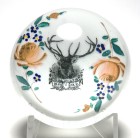 |
|
|
Very Early Francis Whittemore Miniature
Yellow Lampwork Flower with Pink Ground Paperweight.
circa 1962 - 1969. This very early paperweight by Francis
Whittemore features a six petal yellow flower with two green
leaves and a stem. It is signed in the design with an early
Whittemore signature cane. The cane has a black "W" on a
yellow background. The design is placed on a pink
ground. It is an important early example of Francis
Whittemore's work and worthy of any collection of Whittemore
paperweights. Note: This lampwork flower paperweight is similar to the millefiori type examples with the same frit ground offered in Larry Selman's first two editions of "CATALOGUE OF COLLECTORS' PAPERWEIGHTS". See the 1970 Catalog (robins egg blue cover) or the 1971 Catalog (olive green cover). Francis Dyer Whittemore, Jr. is considered one of the pioneers of the modern paperweight renaissance. He started working in glass in 1938, but did not start making paperweights until 1962. His studio was in Lansdale, Pennsylvania. Like many other early glass artists, Francis started his career as a scientific glass blower and then later taught glass as an instructor. For five years, he spent one month a year consulting at Baccarat to help them refine their lampwork paperweight art. Some sources have this consulting work from 1971 to 1976. Other sources have it starting later. The signature cane used on this paperweight was one he developed prior to working at Baccarat. Most of his paperweights are miniature to medium in size. You can read about Francis Whittemore in the book American Glass Paperweights and Their Makers by Jean Melvin (1970). Size: 2 5/16" diameter by 1 3/16" high. This paperweight has a very low profile. The base is polished concave.Signature: Signed in the design with an early Whittemore signature cane. The cane has a black "W" on a yellow background. Condition: Excellent condition. No chips, cracks, or scratches found on inspection. For extra pictures, click on the picture at the right and the following links: Large picture$195 postage paid in the US. Click on the picture to see a larger image. |
 |
| 1172 | Vintage Ravenna Style Five Petal Lily
Flower Paperweight. circa 1880-1940. This paperweight
features a five petal red lily flower with a multi-colored frit
ground. The ground has six pleats. There is a
carefully placed bubble in the center.
This style is associated with the Ravenna Glass factory in Northeastern Ohio. It is called an icepick flower design because an icepick type tool is pushed down through the color to create a stem for the flower and also to create the pleats in the ground. Although the style is associated with Ravenna, I cannot be sure when or where this paperweight was made. Most likely it was made in the first half of the 19th century. This style of paperweight was first documented in the article on Ravenna Glass by H. M. Lyon February 1940 issue of Hobbies Magazine (see pages 51-53). The article has black and white pictures of four paperweights of this style. There is also two similar paperweights in the Bergstrom-Mahler Museum, one of which was acquired in 1941. See No. 438 and 656 in Glass Paperweights of the Bergstrom-Mahler Museum by Geraldine J. Casper. Size: 2 3/4" diameter by 2 1/4" high.
Unsigned. circa 1880-1940. $95 postage paid in the US. Click on the picture to see a larger image. |
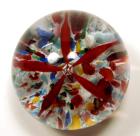 |
| 2184 | Vintage Magnum Trumpet Flower
Paperweight. circa 1950. Great magnum trumpet
flower paperweight by unknown maker. The design consists
double layer of a rust colored trumpet flowers or icepick flowers
over a green and white ground. There are nine flowers in all, each
with a deliberate bubble in the center. The top layer has
five flowers and the bottom layer has four. This has all the
characteristics of a true whimsy, made in spare time by a glass
worker. I believe this was made in the midwest US around the
middle of the 20th century.
It is hard to see the details in the picture because of the uniform color. The glass has a green color. This design is sometimes called an icepick flower design because an icepick type tool is pushed down through the frit later to create the stems for the flowers. In this case, because the bubbles and stems are so large, the took would have been larger than an icepick. Very Large Size: Just over 4" diameter by 3 1/2"
high. This paperweight weighs 3 pounds. circa. 1950.
$40 postage paid in the US. Click on the picture to see a larger image. |
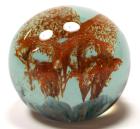 |
| 5992 | Vintage Pairpoint Concentric Millefiori
Sampler Paperweight. circa 1970s. This is a
wonderful spaced millefiori paperweight with twelve different
pieces of glass placed on a two layer turquoise ground.
Included are three complex millefiori canes, a Clichy style rose,
Clichy style pastry mold cane, a miniature cameo, two twist canes,
three large shards, and a bit of something else. The
millefiori canes are especially nice. The ground has a
translucent layer above an opaque layer, which makes the canes
look like they stand proud above the ground but when viewed from
the side it is clear that the top of the canes are actually level
with the top of the translucent layer. It is faceted with a
top facet and five side facets. The facets are
concave. I believe this paperweight dates from the early
1970s when William Burchfield was still at Pairpoint. The
paperweight is signed on the base with an engraved "P" inside a
diamond. This is an interesting addition to any collection
of millefiori paperweights. Note: According to glass artist Jim Poore, the glass fragments in this paperweight are from Pairpoint's attempts to replicate Mount Washington Glass Company "Lava" glass from the 1880s. We don't know why they ended up in this paperweight. Maybe it was an experiment to test the compatibility of the glass or a training piece or just a curiosity? I call it a millefiori sampler. Pairpoint Glass has a long history extending back to its earliest origins with Mount Washington Glass in 1837. Owners and locations changed a number of times and the name Pairpoint was first used in the 1890s. The original Pairpoint companies were located in New Bedford, Massachusetts. In 1938, it was reorganized as Gunderson Glass Works by owner Robert Gunderson and later renamed the Gunderson - Pairpoint Glass Works in 1952. The name was acquired by Robert Bryden and the company moved briefly to East Wareham, MA in 1957 where it operated as the Pairpoint Glass Company. They leased production facilities in Spain. The last New Bedford factory burned down in 1965. In its latest iteration, Robert Bryden moved Pairpoint to Sagamore, Massachusetts in 1970. It continues to operate at that location today, with new owners in 2015. William Clark Burchfield started making paperweights at Pairpoint Glass in Sagamore, Massachusetts
in 1970. He left in
1976 to form the Cape Cod Glass Works (also in Sagamore) which
continued in operation until 2000. It then continued
briefly in Crossville, Tennessee until 2001. Bill
Burchfield died in 2012. Bill's son Mark was also at the
Cape Cod Glass Works until 1998. Size: 2 9/16" diameter by 1 11/16" high. The
base is polished flat with remnants of the pontil scar.
Some rough areas on the base. It is faceted with a top
facet and five side facets. The facets are concave.
For extra pictures, click on the picture at the right and the following links: Large pictureSOLD. Click on the picture to see a larger image. |
Click
on the picture to see a larger image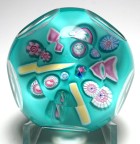 |
| 3112 | Magnum Antique Union Glass (Somerville,
Massachusetts) Paperweight "GEORGE M FLINT". Circa
1900-1929. This is a great Union Glass Company Paperweight
featuring a garland of eight lampwork flowers and the name "GEORGE
M FLINT" in the center. There are four red flowers and four
blue flowers, each with four petals, four light blue sepals, and a
white dot in the center. The letter "G" at the beginning of
"GEORGE" is reversed. In perfect condition. Union Glass Company of Somerville, Massachusetts is the third of three related factories in the Boston area. The first two were the Boston & Sandwich (B&S) Glass Company and the New England Glass Company (NEGC). Both B&S and NEGC produced paperweights at the same time, both were founded by Deming Jarvis, and both declared bankruptcy in 1888. Union Glass came a little later. It operated from 1851 to 1929. These name/date paperweights are made with lampwork flowers and letters and are not frit weights. There are some nice articles in the literature including a lengthy article in the Paperweight Collectors Association 2004 Annual Bulletin. There is also a short chapter in George Kulles' third book - Identifying Antique Paperweights - The Less Familiar. Nicholas Lutz worked at Union Glass from 1895 to 1904 and his influence can be seen on the Union Glass flowers although most of these weights were made after Lutz's death. There is some current speculation that Lutz had an apprentice who continued to work at Union Glass and was responsible for not only some of the better Union Glass examples, but also some of the fine lampwork paperweights attributed to Mount Washington Glass. Very Large Size: Just under 3 11/16" diameter by 2
5/16" high. It weighs 2 pounds 2 ounces. The
bottom is ground flat with a clear finish. For extra pictures, click on the picture at the right and the following links: Large picture$345 postage paid in the US. Click on the picture to see a larger image. |
Click
on the picture to see a larger image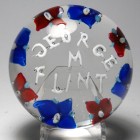 |
| 2257 | Large Antique Dorflinger Red over White
Petaled Lily-Style Paperweight. circa 1895-1920.
This lily paperweight has
four large red petals or panels, each with a red color over a
white base. The petals form a deep well in the
center. They are pleated with a large bubble and second
smaller bubble between each pleat. There is also a larger
center bubble. The petals are formed by
pushing the top of the design down with a crimp. The
paperweight is confirmed to have been made at Dorflinger
Glass. An amazing large paperweight with considerable
depth. This style of paperweight is referred to as a lily paperweight. It is similar to the pleated umbrella-style paperweights and paperweight inkwells made at Whitall Tatum in Millville, NJ (circa 1900-1912). The Millville umbrella designs usually have more pleats, typically eight, but four paneled examples also exist. The umbrella shaped weights were originally modeled to resemble the wild tiger lily of Southern New Jersey. C. Dorflinger & Sons Glass Company was founded by Christian Dorflinger in White Mills, PA in 1865. Paperweight stoppers for bottles were made by Nicholas and Francois Lutz at Dorflinger during the period 1866-1870. Lily style paperweights and other large paperweights, some with foil lettering and dates, were made by other glass workers at Dorflinger from 1895 to 1920. Recent research at the Dorflinger Glass Museum has located a catalog including references to paperweights. Most of the credit for the later styles of paperweights has been given to Tobias N. Hagberg and Ernst Von Dohln, although other Dorflinger workers also tried their hand. None of the paperweights is dated later than 1915. Christian Dorflinger died in 1915 and the business closed in 1921. Large Size : 3 5/`6” diameter by 3 3/4"
high. The base is ground flat. For extra pictures, click on the picture at the right and the following links: Large picture$395 postage paid in the US. Click on the picture to see a larger image. |
Click
on the picture to see a larger image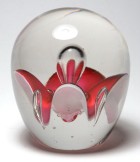 |
| 5968 | Francis Whittemore Miniature Faceted
Pink Crimp Rose Upright Pedestal Paperweight. circa
1970. This miniature upright pedestal paperweight features a
magnificent pink crimp rose with twelve variegated pink petals and
four upturned green sepals. The petals are arranged in
Whittemore's 3+3+3+3 crimp pattern. It is signed on the
underside of the rose with an early Whittemore signature
cane. The signature cane has a black "W" on a yellow
background. The design is set on a clear ground and
supported by a pedestal base. It is faceted with one large
top facet and five side facets. A fantastic addition to any
collection of glass paperweights. Francis Dyer Whittemore, Jr. is considered one of the pioneers of the modern paperweight renaissance. He started working in glass in 1938, originally as a scientific glass maker and instructor in South Jersey. He did not start making paperweights until 1962 when he set up a studio in Lansdale, Pennsylvania. For five years, he spent one month a year consulting at Baccarat to help them refine their lampwork paperweight art. Some sources have this consulting work from 1971 to 1976. Other sources have it starting later. The signature cane used on this paperweight was one he developed prior to working at Baccarat. Most of his paperweights are miniature to medium in size. You can read about Francis Whittemore in the book American Glass Paperweights and Their Makers by Jean Melvin (1970). Miniature size: 1 5/8" diameter by 2 3/16" high. The base of the pedestal has a 1 5/8" diameter. The bottom is ground slightly concave.Signature: Signed on the underside of the rose with an early Whittemore signature cane. The cane has a black "W" on a yellow background. Condition: Excellent condition. No chips, cracks, or scratches found on inspection. For extra pictures, click on the picture at the right and the following links: Large picture$395 postage paid in the US. Click on the picture to see a larger image. |
Click
on the picture to see a larger image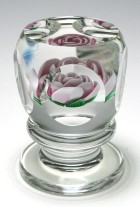 |
| 4742 | Antique Millville Style Magnum Rock of
Ages Four Color Frit Paperweight. circa
1900-1920. This frit paperweight features a rare four color
Rock of Ages motif with a turquoise cross on a rock in the middle
of the water. There is a brown or dark red vine growing on
the cross. The text "ROCK OF AGES" appears in blue and red
above the cross. The design is set in colored frit on an
opaque white enamel ground. The white ground color wraps
around to the base and covers the base except for a clear circle
in the center of the base where the pontil rod would have
been. This paperweight was probably made at the Whitall
Tatum factory in Millville, New Jersey in the first quarter of the
19th century. Some collectors believe that the clear circle
on the base points to the Corning, NY area rather than Millville
as the place of manufacture. A great addition to any
collection of antique American paperweights. Note: This is a very nice clean example but I did find a very faint small (1/8”) partial circular impact mark on careful inspection. Please review the pictures. Frit refers to the powdered glass used to make the design. The design is set up in frit in a metal die and then picked up with a gather of the ground color. When encased, there is sometimes a ridge or crease line between the solid (in this case white) base area and the clear encasement. Some collectors refer to this as two piece construction. This type of construction has been associated with Whitall Tatum and other factories in the Millville area. There is no crease on this paperweight, but the encasement stops where the white ground color starts. Whitall Tatum was one of the first glass factories in America. Located in Millville, New Jersey, it was in operation from 1806 through 1938. The factory in Millville was purchased by a series of companies and eventually shut down in 1999. It is believed that Whitall Tatum workers were allowed to make paperweights from as early as 1860 until the practice was discouraged sometime after 1912. Some collectors believe that the clear circle on the base points to the Corning, NY area rather than Millville as the place of manufacture. There is no documentary proof to support this, but a number of weights of this type (with the clear circle on the base) have been found in the Corning area. According to Newell's Old Glass Paperweights of Southern New Jersey , frit weights were made as early as 1863. Newell identifies this style as a true American folk art and gives a history of paperweight making at Whitall Tatum and other South Jersey factories. Very large size: 3 11/16” diameter by 2 9/16”
high. The base is ground flat. This paperweight
weighs 34 ounces. For extra pictures, click on the picture at the right and the following links: Large picture$195 postage paid in the US. Click on the picture to see a larger image. |
Click
on the picture to see a larger image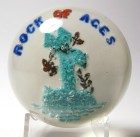 |
| 2398 | Antique Magnum Millville Masonic Frit
Paperweight. circa 1880-1920. This
antique frit paperweight features a Mason's square and compass
symbol with a "G" in the center. It was made in Millville,
New Jersey around the end of the 19th century. Blue and red
ground glass (frit) was used to make the design on a white
ground. The glass has a slightly green tint that is
exaggerated in the pictures. The profile is relatively
flat. The paperweight was made for the Masons, a fraternal
organization, probably at the Whitall Tatum factory in Millville,
New Jersey. Frit refers to the powdered glass used to make the design. The design is set up in frit in a metal die and then picked up with a gather of the ground color. When encased, there is sometimes a ridge or crease line between the solid (in this case white) base area and the clear encasement. Collectors refer to this as two piece construction. This type of construction has been associated with Whitall Tatum and other factories in the Millville area. There is no crease on this paperweight, but the encasement stops where the white ground color starts. Note: Sometimes this style of paperweight will have an clear circle in the center of the base where the pontil would have been attached. Because a number of weights of this type (with the clear circle on the base) have been found in the Corning area, some collectors conjectured that the paperweights with a clear circle on the base were made in the Corning, NY area rather than Millville, NJ. I reject that conjecture as I have had this exact design with and without the clear circle. I believe both types were made in Millville and the difference is how much glass is removed when grinding the base to remove the pontil scar. Whitall Tatum was one of the first glass factories in America. Located in Millville, New Jersey, it was in operation from 1806 through 1938. The factory in Millville was purchased by a series of companies and eventually shut down in 1999. It is believed that Whitall Tatum workers were allowed to make paperweights from as early as 1860 until the practice was discouraged sometime after 1912. According to Newell's Old Glass Paperweights of Southern New Jersey , frit weights were made as early as 1863. Newell identifies this style as a true American folk art and gives a history of paperweight making at Whitall Tatum and other South Jersey factories. Very large size: Just over 3 1/4" diameter by 1
7/8" high. The profile is relatively flat. The base
is ground flat. For extra pictures, click on the picture at the right and the following links: Large picture$145 postage paid in the US. Click on the picture to see a larger image. |
Click
on the picture to see a larger image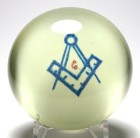
|
| 6030 | Large Pairpoint Faceted Red Rose
Paperweight. circa 1970-1990. This paperweight
features a red rose and eight leaves placed over clear
ground. The rose has fourteen variegated red petals in a
4+4+3+3 crimp pattern plus two tiny petals in the center. In
the typical Pairpoint style, there are four wide green sepals and
four skinny sepals. It has one top facet. The
paperweight is unsigned but I guarantee that it was made by
Pairpoint glass. A beautiful example of modern Pairpoint
production. Pairpoint Glass has a long history extending back to its earliest origins with Mount Washington Glass in 1837. Owners and locations changed a number of times and the name Pairpoint was first used in the 1890s. The original Pairpoint companies were located in New Bedford, Massachusetts. In 1938, it was reorganized as Gunderson Glass Works by owner Robert Gunderson and later renamed the Gunderson - Pairpoint Glass Works in 1952. The name was acquired by Robert Bryden and the company moved briefly to East Wareham, MA in 1957 where it operated as the Pairpoint Glass Company. They leased production facilities in Spain. The last New Bedford factory burned down in 1965. In its latest iteration, Robert Bryden moved Pairpoint to Sagamore, Massachusetts in 1970. It continues to operate at that location today (2024) although under new owners. Size: 3" diameter by just under 2" high. The
base is polished flat. It has one top facet. For extra pictures, click on the picture at the right and the following links: Large pictureSOLD. Click on the picture to see a larger image. |
Click
on the picture to see a larger image
|
| 5265 | Francis Whittemore Miniature Yellow
Pears with Leaves and Seed Pod Paperweight. circa 1971
- 1980. This paperweight features two yellow pears along
with three green leaves, and a seed pod. It is signed in the
design with a fancy Whittemore "W" compound signature cane.
The signature cane is a white "W" on a blue background surrounded
by a ring of white stars. The design is placed on a
translucent green ground. Whittemore revisited this theme
several times during his career as a paperweight maker. A
beautiful example. Note: This was a difficult paperweight to photograph. The highly reflective surface even picked up a reflection of my hand and my camera. If you need more pictures please let me know. Francis Dyer Whittemore, Jr. is considered one of the pioneers of the modern paperweight renaissance. He started working in glass in 1938, but did not start making paperweights until 1962. His studio was in Lansdale, Pennsylvania. Like many other early glass artists, Francis started his career as a scientific glass blower and then later taught glass as an instructor. For five years, he spent one month a year consulting at Baccarat to help them refine their lampwork paperweight art. Some sources have this consulting work from 1971 to 1976. Other sources have it starting later. The signature cane used on this paperweight was one he developed during the period that he was consulting at Baccarat. Most of his paperweights are miniature to medium in size. You can read about Francis Whittemore in the book American Glass Paperweights and Their Makers by Jean Melvin (1970). Miniature size: Just under 2 1/16"
diameter by 1 11/16" high. The bottom is ground concave. For extra pictures, click on the picture at the right and the following links: Large pictureSOLD. Click on the picture to see a larger image. |
Click
on the picture to see a larger image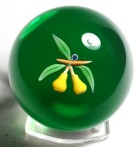 |
| 2850 | Unsigned Miniature Lampwork Flower
Paperweight, possibly by Ronald Hansen.
undated. This miniature paperweight features a six petal
lampwork flower with leaves and stem. The petals are yellow
with orange stripes. There are five variegated sepals and
plus two leaves and a stem. It has a low profile.
Nicely executed, it has an unusual amber ground placed over a
white button base (see picture of the base). Definitely the
work of a talented artist. Possibly by Ronald Hansen. Note: The maker of paperweight is unknown, but it is possibly by Ronald Hansen who made paperweights from the late 1950s to 1971. Ronald E. Hansen was born in Virginia, Minnesota in 1910. He was first exposed to glass lampwork as a child when he was befriended by Bohemian glassworkers in a "hobo village" making glass ships. He later worked as the director of the Neon Tube School in Detroit, Michigan. With this exposure, he was aware of the artistic and technical aspects of glassworking. He established his own studio in Mackinaw City, Michigan, mixed his own colors and glass, and created a variety of small glass paperweights, most of which are 2 1/2" or less in diameter. He made paperweights from the late 1950s to 1971. He was one of a number of glass artists in this paperweight making family. His nephew, Eric Hansen, continues the art today. You can read more about Ronald E. Hansen in the book American Glass Paperweights and their makers by Jean Melvin (1970 Revised edition) or the article by Nancy Alfano in the 2004 PCA Bulletin. Very small size: Low profile, 1 15/16" diameter by just over 1" high. The base is ground flat with a frosted finish.Signature: Unsigned. I believe this paperweight was made by Ronald Hansen, but have been unable to confirm this ID. Condition: Very good condition with a few faint scratches or scuffed areas. For extra pictures, click on the picture at the right and the following links: Large pictureSOLD. Click on the picture to see a larger image. |
Click
on the picture to see a larger image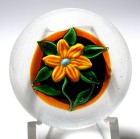 |
| 2276 | Vintage American "FROM A FRIEND" Frit
Paperweight - Probably Made by Gentile Glass. circa
1900-1974. This frit paperweight features a "FROM A FRIEND"
message in white frit with an outer wreath garland. The
design is placed over a multi-colored ground of larger glass
chips. A great gift item to raise a friend's spirits.
This example in unsigned but I suspect it was made at Gentile
Glass in Star City, West Virginia based on the shape and bottom
finish. An identical example of the paperweight and the die
used to produce the design are shown in American Glass
Paperweights and Their Makers (1970) by Jean Melvin (see
pages 69 - 71). This is a great addition to any collection
of American paperweights. The Melvin book mentions that the motto weights like the "FROM A FRIEND" paperweight were popular items sold to distributors and gift shops throughout the US and Canada. The dies were originally used by Peter Gentile when he worked at the Fry Factory in Rochester, NY and continued to be used by the Gentile factory once they started their own factory. This style of paperweight was made by many glass companies throughout the glass producing areas of the midwestern US (Ohio, Indiana, West Virginia, or even New Jersey) in the first half of the 20th century and later. Frit refers to the powdered glass used to make the design. The design is set up in a metal die and then picked up with a gather of a ground color. Sometimes the maker can be identified by researching the mold or die used to set up the design. According to Newell's Old Glass Paperweights of Southern New Jersey , frit weights were made as early as 1863. Newell identifies this style as a true folk art. The original glass worker in the Gentile
family was Peter Gentile, born in Naples, Italy in
1884. He worked in Naples(Italy), Rochester
(Pennsylvania), and Morgantown (West Virginia) before building
his own factory in Star City (West Virginia) in 1947.
Originally the factory was a short-lived partnership (G. and
F. Glass Co.) with John Funfrock, a mold maker. His
sons, Frankie, John and Joe Gentile helped him make
paperweights in the off hours at the Guild Factory in
Morgantown. However, most paperweight production since
WWII has been associated with Peter, John, or John's wife
Gertrude Gentile. Few weights were signed prior to
1963. John Gentile passed away in 2006 and it is
believed that Gentile Glass closed down after his death.
Most, if not all, paperweights produced from 1975 on were
signed. For more information, you can read about the
Gentile Family in the book American Glass Paperweights and
Their Makers by Jean Melvin (1967 and 1970). Large Size: 3 5/16" diameter by 2 3/4" high.
The base is fire finished. For extra pictures, click on the picture at the right and the following links: Large pictureSOLD. Click on the picture to see a larger image. |
Click
on the picture to see a larger image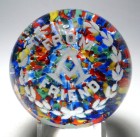 |
| 5278 | Very Early Francis Whittemore Miniature
Paperweight with White and Blue Millefiori Flowers on a Pink
Ground. circa 1962 - 1969. This very early
paperweight by Francis Whittemore features five small white
millefiori flowers with blue star centers. There is also a
stem and two green leaves. The design is placed on a powdery
pink ground. This paperweight is signed in the design with
an early Whittemore signature cane, a black "W" on a yellow
background. This is an important early example of
Francis Whittemore's work and worthy of any collection of
Whittemore paperweights. Note: This paperweight is almost the same as the examples offered in Larry Selman's first two editions of "CATALOGUE OF COLLECTORS' PAPERWEIGHTS". See the 1970 Catalog (robins egg blue cover) or the 1971 Catalog (olive green cover). Francis Dyer Whittemore, Jr. is considered one of the pioneers of the modern paperweight renaissance. He started working in glass in 1938, but did not start making paperweights until 1962. His studio was in Lansdale, Pennsylvania. Like many other early glass artists, Francis started his career as a scientific glass blower and then later taught glass as an instructor. For five years, he spent one month a year consulting at Baccarat to help them refine their lampwork paperweight art. Some sources have this consulting work from 1971 to 1976. Other sources have it starting later. The signature cane used on this paperweight was one he developed prior to working at Baccarat. Most of his paperweights are miniature to medium in size. You can read about Francis Whittemore in the book American Glass Paperweights and Their Makers by Jean Melvin (1970). Size: 2 3/8" diameter by 1 1/8" high. This paperweight has a very low profile. The base is flat with a concave center.Signature: Signed in the design with an early Whittemore signature cane. The cane has a black "W" on a yellow background. Condition: Excellent condition. No chips, cracks, or scratches found on inspection. There are many bubbles in the ground and a few striations in the glass. For extra pictures, click on the picture at the right and the following links: Large picture$165 postage paid in the US. Click on the picture to see a larger image. |
Click
on the picture to see a larger image |
| 5956 | Large Ed Rithner Multi-Colored Candy
Cane Millefiori Paperweight. circa 1940-1970. A
wonderful example of a relatively rare style of paperweight.
The millefiori canes are striped lengthwise and are placed over a
transparent turquoise ground. The canes are various
colors of red, green, and white. A classic Rithner design. Note: As shown in the side view, there are many striations (sugaring) in the glass. Still, the paperweight views beautifully. Ed Rithner worked in Wellsburg, West Virginia from 1908 to the 1970s or later. You can read about Ed Rithner in Jean Melvin's book on American Glass Paperweights and their Makers . All of Rithner's weights are unsigned. Large Size: 2 15/16" diameter by 2" high.
The base is fire finished and then ground to a matte finish in
the center to remove the pontil mark. For extra pictures, click on the picture at the right and the following links: Large pictureSOLD. Click on the picture to see a larger image. |
Click
on the picture to see a larger image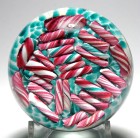 |
| 5374 | Large Pairpoint Faceted Red Rose
Paperweight. circa 1970-1980. This paperweight
features a large red crimp rose made at Pairpoint Glass in
Sagamore, Massachusetts. The
rose has 13 petals with a 4+4+3+2 pattern. There are also
eight variegated green leaves, four large and four skinny.
The design is placed over a semi-transparent dark
blue ground. It is faceted with one large top facet plus
five smaller side facets. The glass has a green tinge.
The paperweight is unsigned. It
is possible that this rose paperweight was made by Robbie Mason
or one of the other glass artists who apprenticed with
him. A wonderful example of a modern Pairpoint rose
paperweight. Note on condition: This paperweight has a faint 3/16" circular impact mark and a faint 3/16" vertical scratch on the side near the top facet. There is some wear on the base. I found no other damage. There are also small bubbles and a couple of white flecks in the glass from when it was made. I believe it dates from the early period in Sagamore when they sometimes had white "stones" in the glass thrown off by the furnace pots. Pairpoint Glass has a
long history extending back to its earliest origins with Mount
Washington Glass in 1837. Owners and locations changed a
number of times and the name Pairpoint was first used in the
1890s. The original Pairpoint companies were located in
New Bedford, Massachusetts. In 1938, it was reorganized
as Gunderson Glass Works by owner Robert Gunderson and later
renamed the Gunderson - Pairpoint Glass Works in 1952.
The name was acquired by Robert Bryden and the company moved
briefly to East Wareham, MA in 1957 where it operated as the
Pairpoint Glass Company. They leased production
facilities in Spain. The old New Bedford factory burned
down in 1965. In its latest iteration, Robert Bryden
moved Pairpoint to Sagamore, Massachusetts in 1969.
Attempts were made to resume glassmaking in New Bedford for
five years (1977-1982), but this was not successful.
Bryden retired in September 1988. Since then, the
Pairpoint Glass Company has changed owners again. It
continues to operate at that location today (2022) although under new owners. Robert (Robbie) C. Mason (1935-2020) started his glass career in 1950 as an apprentice with Edinburgh Crystal, Scotland (part of the Thomas Webb and Sons). With exception of three years in the Army (1960-1963), he continued to gain seniority and expertise as a glass maker. In 1968, Thomas Bryden advertised in the Edinburgh Evening News for experienced glass workers emphasizing the need for hand made experience. Robbie Mason decided to take a chance on a new employer and joined Pairpoint in 1969. With his experience, he became a gaffer by 1971. He stayed at Pairpoint as a master glassblower until he retired in 2005. A number of well known glass artists apprenticed with him. He retired in 2005 and passed away from complications of COVID-19 in April 2020. Large Size: 2 13/16" diameter by 2 1/4"
high. The bottom is ground concave in the center. It is
faceted with one top facet and five side facets. For extra pictures, click on the picture at the right and the following links: Large pictureSOLD. Click on the picture to see a larger image. |
Click
on the picture to see a larger image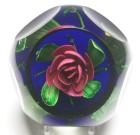
|
| 5688 | Large Tom Mosser Train Scene with
Flagman Paperweight. circa 1970. This
classic decorative plaque paperweight was made by Thomas Mosser at
his Variety Glass Company in Cambridge Ohio. The white
enamel plaque is decorated with a printed decal image (ceramic
transfer) of an old locomotive with cars behind, a building and
tree in the background, a picket fence in the foreground, and an
engineer in the cab. A flagman is signalling the engineer to
proceed through a crossing. There are chickens on the other
side of the rails. Look at those big headlights on the
engine. It is signed with an "M" in the lower right edge of
the scene. The plaque rests on a multi-colored frit ground
with a second frit ground below. A great example from this
Cambridge Ohio maker. Note: I've always assumed Mosser used stock images based on Currier and Ives prints or those of another illustrator. I've been unable to identify the original artist. That said, it is obvious that this is not a hand painted scene. You can see the grain from the original transfer. Thomas Mosser (born 1927) learned to work with glass at the Cambridge Glass Company where his father Orie Mosser was the plant manager. When Cambridge Glass closed in 1954, Tom decided to continue in the glass business and formed Variety Glass with the support of several experienced glass workers from Cambridge. The first couple of locations failed due to fires, but eventually a stable operation emerged and produced a variety of products, including glassware for the pharmaceutical industry, medical supplies, and also collectible molded items such as novelty salts, jam dishes, toothpick holders, ashtrays, and miniature boot and shoes. Tom also made paperweights to order as well as fixed designs for Shrine and Masonic lodges. Many of his paperweights used ceramic transfers of well known paintings by other artists. For more information, you can read about the Tom Mosser in the book American Glass Paperweights and Their Makers by Jean Melvin (revised 1970). The Mosser family continues to operate a glass business in Cambridge Ohio. Large size: 2 13/16" diameter by 2 3/8"
high. The base is polished flat. It weighs just over
16 ounces and will be two pounds when packaged for mailing. For extra pictures, click on the picture at the right and the following links: Large pictureSOLD. Click on the picture to see a larger image. |
Click
on the picture to see a larger image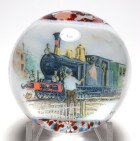 |
Back to Allan's Paperweights (www.paperweights.com)
Revised 8/8/2025 ei9